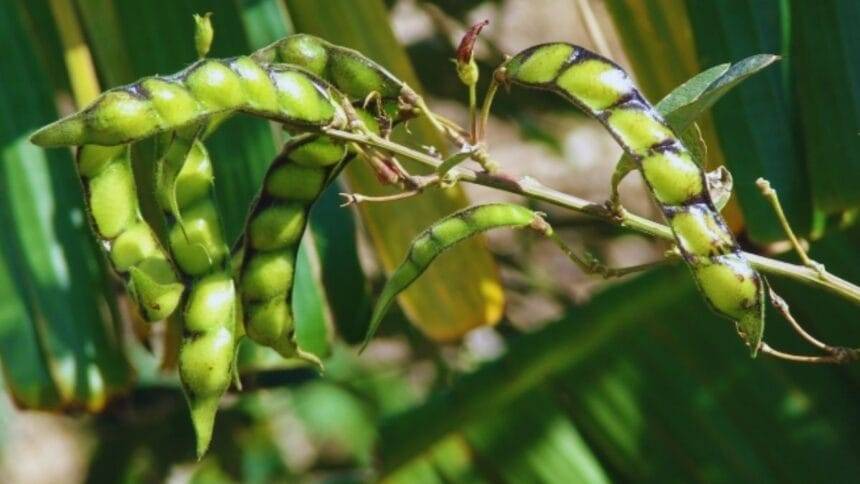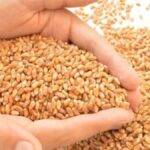Main Points In Hindi (मुख्य बातें – हिंदी में)
यहाँ कुछ मुख्य बिंदु दिए गए हैं:
-
बीमारियों के प्रति सतर्कता: बारहमासी फसलें जैसे मूँगफली, चना और दालें इस मौसम में कई बीमारियों का शिकार हो सकती हैं, विशेषकर जब फसल को ठंड में सिंचाई की जाती है। किसानों को नई पौधों की निगरानी करनी चाहिए।
-
उखथा रोग के लक्षण: अगर किसी दाल के पौधे सुबह हरे दिखाई देते हैं और दोपहर में मुरझा जाते हैं, तो यह उखथा रोग का संकेत है। इससे पौधा सूख जाता है और इससे किसानों को भारी नुकसान होता है।
-
चना की बीमारियाँ: चना फसल को विभिन्न बीमारियों का खतरा होता है, लेकिन चना ब्लाइट सबसे ज्यादा प्रभावित करता है। इसे "दालों का राजा" कहा जाता है और यह मिट्टी की उर्वरता बढ़ाने में सहायक होता है।
-
रोकथाम के उपाय: बीमारियों से निपटने के लिए, बीजों को Rhizobium कल्चर और Carbendazim के साथ उपचारित करना चाहिए। इसके अलावा, पौधों की जड़ों में Copper Oxychloride का उपयोग करना आवश्यक है।
- हारदा और स्टेमफीलियम बाइलाइट रोग: हारदा रोग में पौधों के पत्तों और तनों पर काले फफोले दिखाई देते हैं, जबकि स्टेमफीलियम बाइलाइट में छोटे काले धब्बे बनते हैं। इन रोगों के उपचार के लिए Carbendazim और Mancozeb का मिश्रण प्रभावी होता है।
Main Points In English(मुख्य बातें – अंग्रेज़ी में)
Here are the main points from the provided text regarding the cultivation of pulse crops and the diseases that can affect them:


-
Awareness of Weather-Related Diseases: Farmers cultivating pulse crops like pigeon pea, gram, and lentils should be vigilant during mildly cold weather, as it can lead to various diseases, particularly when crops are irrigated during this period.
-
Ukhatha Disease Symptoms: A key symptom of Ukhatha disease is the wilting of pulse plants by afternoon after being green in the morning. This disease can lead to entire plants drying up, resulting in significant losses for farmers.
-
Impact of Gram Blight: Gram blight is particularly harmful to gram crops, which are vital in India. The disease affects the yield and, consequently, the financial stability of farmers, as gram contributes to soil fertility by fixing nitrogen.
-
Preventive Measures: Farmers are advised to treat seeds with Rhizobium culture and fungicides like Carbendazim before sowing. For symptoms of rotting disease, using Copper Oxychloride is recommended.
- Harda and Stemphylium Blight Diseases: Harda disease is characterized by black blisters on various plant parts, while Stemphylium blight presents as small black spots on leaves. Timely treatment with Carbendazim is essential for both diseases to minimize damage.
Complete News In Hindi(पूरी खबर – हिंदी में)
अगर आप चने, मूँगफली, मसूर जैसी फलियों की फसल उगाते हैं, तो यह खबर आपके लिए है। यह खबर आपको उनके द्वारा होने वाली बीमारियों के प्रति सचेत करती है। वर्तमान में मौसम हल्का ठंडा है, जो कई बीमारियों को आमंत्रित करता है, खासकर जब आप इस ठंडी में फसलों की सिंचाई करते हैं। इसलिए, फसल के नए पौधों पर नज़र रखें और लक्षण पढ़ते रहें ताकि आपको बीमारियों की जानकारी मिल सके। एक लक्षण यह है कि अगर सुबह पौधा हरा है और दोपहर तक मुरझा जाता है, तो सतर्क रहें। यह एक गंभीर बीमारी का संकेत है।
जब उखता रोग होता है, तो फलियों का पौधा सुबह को हरा रहता है और दोपहर में मुरझा जाता है। बाद में पूरा पौधा सूख जाता है। इससे किसानों को बहुत नुकसान होता है क्योंकि उन्हें बीज, सिंचाई, श्रम लागत आदि में खर्च करने पड़ते हैं। अगर आप अपनी फलियों की फसल में ऐसा लक्षण देखते हैं, तो तुरंत बीमारी का इलाज शुरू करें।
सुखने की बीमारी से नुकसान
फलियों के बीच, चने की बुवाई सबसे अधिक प्रभावित होती है, जिससे बड़े नुकसान होते हैं। चना भारत में फलियों की फसल में सबसे महत्वपूर्ण स्थान रखता है, इसलिए इसे फलियों का राजा भी कहा जाता है। इसकी हरी पत्तियाँ और हरी तथा सूखी दाल का उपयोग सब्जियों में किया जाता है। चने की छिलका और भूसी पशुओं के चारे में उपयोग होती है। चना एक फसल है, इसलिए इसके जड़ें वातावरण से नाइट्रोजन लेती हैं और उसे मिट्टी में जमा करती हैं, जिससे मिट्टी की उर्वरता बढ़ती है। हालांकि, चना कई बीमारियों के जोखिम में रहता है, जिससे उत्पादन में कमी आती है। इसमें एक बीमारी है उखता, जो इसकी उपज को बहुत प्रभावित करती है।
अगर आप अपनी फसल में फास्फेट की मात्रा बढ़ाना चाहते हैं, तो खेत में ये दो जैविक खाद डालें, यह अम्लीय मिट्टी के लिए अमृत है।
फलियों में बीमारी से निपटने के लिए, बीज बोने से पहले 5 ग्राम ट्राइकोडर्मा या 2 ग्राम कार्बेन्डाजिम प्रति किलोग्राम बीज के साथ बीजों का उपचार करें। अगर फसल में सड़न रोग का लक्षण दिखे, तो पौधों की जड़ों में 3 ग्राम प्रति लीटर पानी में निकलने वाला कॉपर ऑक्सीक्लोराइड 50 का छिड़काव करें।
हरड़ा रोग भी खतरनाक है
फलियों में एक अन्य बीमारी हरड़ा है, जिसमें पौधों के पत्तों, तने, शाखाओं और फली पर काले फफोले नजर आते हैं और पौधे सूख जाते हैं। इसके अलावा, फलियों में स्टेमफिलियम ब्लाइट का संक्रमण होता है। इसमें सबसे पहले पौधे के निचले हिस्से पर बहुत छोटे काले दाग बनते हैं और यह बीमारी पौधे के ऊपरी हिस्से की ओर बढ़ती है। इस बीमारी का समय पर इलाज करना भी आवश्यक है।
किसान इन दोनों बीमारियों के लिए बीजों का उपचार कार्बेन्डाजिम से करें, प्रति किलोग्राम बीज में 2 ग्राम की दर से और फिर बीज बोएं। कार्बेन्डाजिम और मैनकोज़ेब को मिलाकर 1.5 ग्राम प्रति लीटर पानी का घोल बनाकर छिड़काव करें।
Complete News In English(पूरी खबर – अंग्रेज़ी में)
If you have cultivated pulse crops like pigeon pea, gram, lentils etc. then this news is for you. This news is to warn you to be careful about the diseases caused by it. Right now the weather is mildly cold which invites many diseases. Especially when you irrigate crops in this cold. Therefore, keep a close eye on the new plants of pulses and keep reading the symptoms so that you will get information about the diseases. One symptom of this is that if a pulse plant is green in the morning and withers in the afternoon, then be careful. This is a sign of a serious illness.
In fact, when Ukhatha disease occurs, the pulse plant withers in the afternoon and turns green in the morning. Later this entire plant dries up. Due to this, the farmer has to suffer huge losses because his expenses on seeds, irrigation, labor costs etc. are lost. If you see such symptoms in the pulses crop, then immediately start treating the disease.
loss due to squatting disease
Among pulse crops, gram blight affects gram the most, causing massive losses. Gram holds the most important place among the pulse crops of India, hence it is also called the king of pulses. Its green leaves and green and dry grains are used in vegetables. The peel and husk of gram pulses are used in animal feed. Gram is a pulse crop, hence its roots take nitrogen from the atmosphere and fix it in the soil, which increases the fertility of the soil. However, gram is at risk from many diseases due to which production falls. There is a disease in this called Ukhatha which greatly affects its yield.
Also read: If you want to increase the amount of phosphate in the crop, then apply these two organic fertilizers in the field, it is a panacea for acidic soil.
To deal with the disease in pulses, sowing should be done only after treating the seeds with Rhizobium culture at the rate of 5 grams of Trichoderma or 2 grams of Carbendazim per kg of seeds. If symptoms of rotting disease are seen in the crop, apply Copper Oxychloride 50 soluble powder at the rate of 3 grams per liter of water in the root zone of the plants.
Harada disease is also dangerous
A similar disease in pulses is Harda disease in which black blisters appear on the leaves, stem, twigs and pods of the plants and the plants dry up. Apart from this, there is infection of Stemphylium blight in pulse crops. In this, first very small black spots are formed on the leaves of the lower part of the plant and the disease progresses to the upper part of the plant. Timely treatment of this disease is also necessary.
Also read: This puppy eats the stalks of pulse crops, know the solution for prevention
For both these diseases, farmers should treat the seeds with Carbendazim at the rate of 2 grams per kg of seeds and then sow the seeds. Carbendazim and Mancozeb should be mixed and a solution of 1.5 grams per liter of water should be sprayed.










